Zhipeng Wang
AHA: Aligning Large Audio-Language Models for Reasoning Hallucinations via Counterfactual Hard Negatives
Dec 30, 2025Abstract:Although Large Audio-Language Models (LALMs) deliver state-of-the-art (SOTA) performance, they frequently suffer from hallucinations, e.g. generating text not grounded in the audio input. We analyze these grounding failures and identify a distinct taxonomy: Event Omission, False Event Identity, Temporal Relation Error, and Quantitative Temporal Error. To address this, we introduce the AHA (Audio Hallucination Alignment) framework. By leveraging counterfactual hard negative mining, our pipeline constructs a high-quality preference dataset that forces models to distinguish strict acoustic evidence from linguistically plausible fabrications. Additionally, we establish AHA-Eval, a diagnostic benchmark designed to rigorously test these fine-grained temporal reasoning capabilities. We apply this data to align Qwen2.5-Omni. The resulting model, Qwen-Audio-AHA, achieves a 13.7% improvement on AHA-Eval. Crucially, this benefit generalizes beyond our diagnostic set. Our model shows substantial gains on public benchmarks, including 1.3% on MMAU-Test and 1.6% on MMAR, outperforming latest SOTA methods.
Distilling the Essence: Efficient Reasoning Distillation via Sequence Truncation
Dec 24, 2025Abstract:Distilling the reasoning capabilities from a large language model (LLM) to a smaller student model often involves training on substantial amounts of reasoning data. However, distillation over lengthy sequences with prompt (P), chain-of-thought (CoT), and answer (A) segments makes the process computationally expensive. In this work, we investigate how the allocation of supervision across different segments (P, CoT, A) affects student performance. Our analysis shows that selective knowledge distillation over only the CoT tokens can be effective when the prompt and answer information is encompassed by it. Building on this insight, we establish a truncation protocol to quantify computation-quality tradeoffs as a function of sequence length. We observe that training on only the first $50\%$ of tokens of every training sequence can retain, on average, $\approx94\%$ of full-sequence performance on math benchmarks while reducing training time, memory usage, and FLOPs by about $50\%$ each. These findings suggest that reasoning distillation benefits from prioritizing early reasoning tokens and provides a simple lever for computation-quality tradeoffs. Codes are available at https://github.com/weiruichen01/distilling-the-essence.
Reasoning Models Can be Accurately Pruned Via Chain-of-Thought Reconstruction
Sep 15, 2025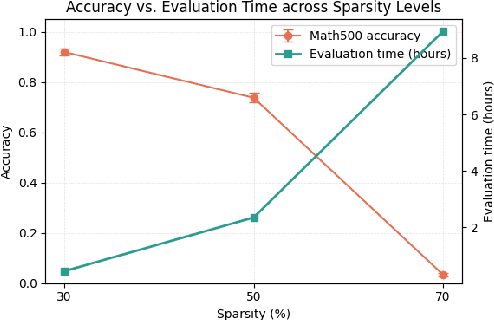
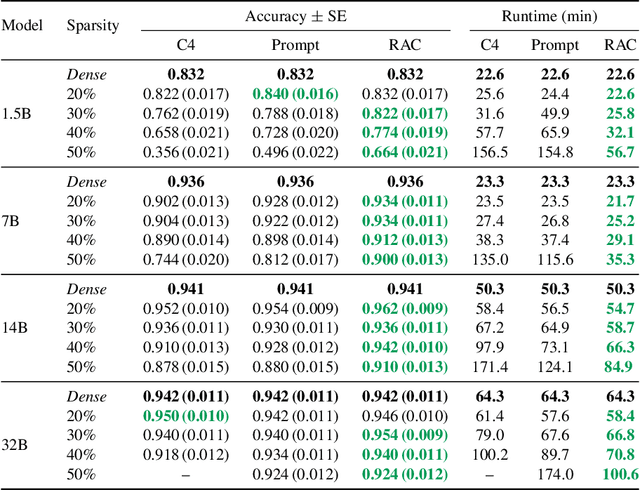
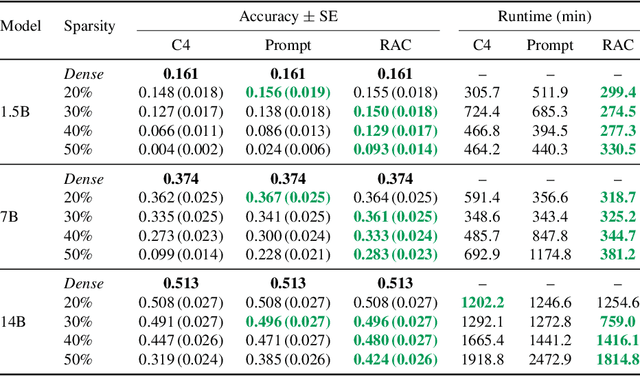
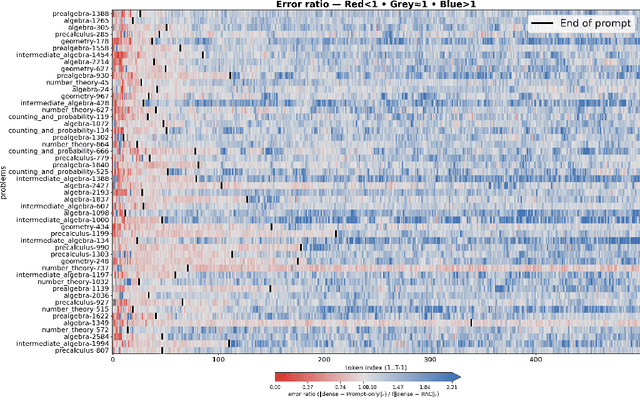
Abstract:Reasoning language models such as DeepSeek-R1 produce long chain-of-thought traces during inference time which make them costly to deploy at scale. We show that using compression techniques such as neural network pruning produces greater performance loss than in typical language modeling tasks, and in some cases can make the model slower since they cause the model to produce more thinking tokens but with worse performance. We show that this is partly due to the fact that standard LLM pruning methods often focus on input reconstruction, whereas reasoning is a decode-dominated task. We introduce a simple, drop-in fix: during pruning we jointly reconstruct activations from the input and the model's on-policy chain-of-thought traces. This "Reasoning-Aware Compression" (RAC) integrates seamlessly into existing pruning workflows such as SparseGPT, and boosts their performance significantly. Code reproducing the results in the paper can be found at: https://github.com/RyanLucas3/RAC
Small Lesions-aware Bidirectional Multimodal Multiscale Fusion Network for Lung Disease Classification
Aug 06, 2025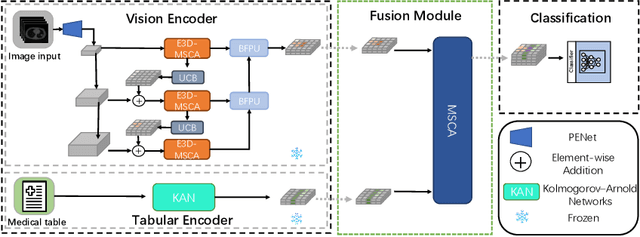

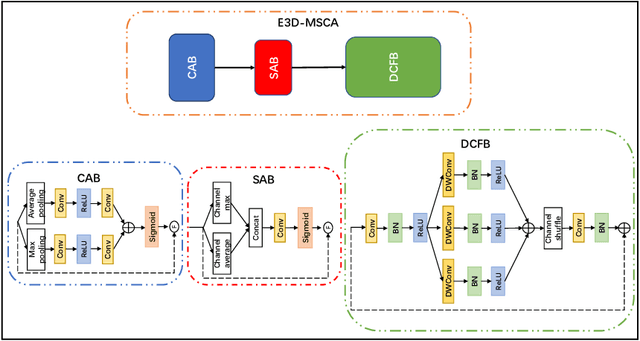

Abstract:The diagnosis of medical diseases faces challenges such as the misdiagnosis of small lesions. Deep learning, particularly multimodal approaches, has shown great potential in the field of medical disease diagnosis. However, the differences in dimensionality between medical imaging and electronic health record data present challenges for effective alignment and fusion. To address these issues, we propose the Multimodal Multiscale Cross-Attention Fusion Network (MMCAF-Net). This model employs a feature pyramid structure combined with an efficient 3D multi-scale convolutional attention module to extract lesion-specific features from 3D medical images. To further enhance multimodal data integration, MMCAF-Net incorporates a multi-scale cross-attention module, which resolves dimensional inconsistencies, enabling more effective feature fusion. We evaluated MMCAF-Net on the Lung-PET-CT-Dx dataset, and the results showed a significant improvement in diagnostic accuracy, surpassing current state-of-the-art methods. The code is available at https://github.com/yjx1234/MMCAF-Net
Local2Global query Alignment for Video Instance Segmentation
Jul 27, 2025Abstract:Online video segmentation methods excel at handling long sequences and capturing gradual changes, making them ideal for real-world applications. However, achieving temporally consistent predictions remains a challenge, especially with gradual accumulation of noise or drift in on-line propagation, abrupt occlusions and scene transitions. This paper introduces Local2Global, an online framework, for video instance segmentation, exhibiting state-of-the-art performance with simple baseline and training purely in online fashion. Leveraging the DETR-based query propagation framework, we introduce two novel sets of queries:(1) local queries that capture initial object-specific spatial features from each frame and (2) global queries containing past spatio-temporal representations. We propose the L2G-aligner, a novel lightweight transformer decoder, to facilitate an early alignment between local and global queries. This alignment allows our model to effectively utilize current frame information while maintaining temporal consistency, producing a smooth transition between frames. Furthermore, L2G-aligner is integrated within the segmentation model, without relying on additional complex heuristics, or memory mechanisms. Extensive experiments across various challenging VIS and VPS datasets showcase the superiority of our method with simple online training, surpassing current benchmarks without bells and rings. For instance, we achieve 54.3 and 49.4 AP on Youtube-VIS-19/-21 datasets and 37.0 AP on OVIS dataset respectively withthe ResNet-50 backbone.
BP-Seg: A graphical model approach to unsupervised and non-contiguous text segmentation using belief propagation
May 22, 2025

Abstract:Text segmentation based on the semantic meaning of sentences is a fundamental task with broad utility in many downstream applications. In this paper, we propose a graphical model-based unsupervised learning approach, named BP-Seg for efficient text segmentation. Our method not only considers local coherence, capturing the intuition that adjacent sentences are often more related, but also effectively groups sentences that are distant in the text yet semantically similar. This is achieved through belief propagation on the carefully constructed graphical models. Experimental results on both an illustrative example and a dataset with long-form documents demonstrate that our method performs favorably compared to competing approaches.
Kaiwu: A Multimodal Manipulation Dataset and Framework for Robot Learning and Human-Robot Interaction
Mar 07, 2025



Abstract:Cutting-edge robot learning techniques including foundation models and imitation learning from humans all pose huge demands on large-scale and high-quality datasets which constitute one of the bottleneck in the general intelligent robot fields. This paper presents the Kaiwu multimodal dataset to address the missing real-world synchronized multimodal data problems in the sophisticated assembling scenario,especially with dynamics information and its fine-grained labelling. The dataset first provides an integration of human,environment and robot data collection framework with 20 subjects and 30 interaction objects resulting in totally 11,664 instances of integrated actions. For each of the demonstration,hand motions,operation pressures,sounds of the assembling process,multi-view videos, high-precision motion capture information,eye gaze with first-person videos,electromyography signals are all recorded. Fine-grained multi-level annotation based on absolute timestamp,and semantic segmentation labelling are performed. Kaiwu dataset aims to facilitate robot learning,dexterous manipulation,human intention investigation and human-robot collaboration research.
Efficient AI in Practice: Training and Deployment of Efficient LLMs for Industry Applications
Feb 20, 2025Abstract:Large language models (LLMs) have demonstrated remarkable performance across a wide range of industrial applications, from search and recommendations to generative tasks. Although scaling laws indicate that larger models generally yield better generalization and performance, their substantial computational requirements often render them impractical for many real-world scenarios at scale. In this paper, we present methods and insights for training small language models (SLMs) that deliver high performance and efficiency in deployment. We focus on two key techniques: (1) knowledge distillation and (2) model compression via quantization and pruning. These approaches enable SLMs to retain much of the quality of their larger counterparts while significantly reducing training, serving costs, and latency. We detail the impact of these techniques on a variety of use cases at a large professional social network platform and share deployment lessons - including hardware optimization strategies that enhance speed and throughput for both predictive and reasoning-based applications.
AIArena: A Blockchain-Based Decentralized AI Training Platform
Dec 19, 2024Abstract:The rapid advancement of AI has underscored critical challenges in its development and implementation, largely due to centralized control by a few major corporations. This concentration of power intensifies biases within AI models, resulting from inadequate governance and oversight mechanisms. Additionally, it limits public involvement and heightens concerns about the integrity of model generation. Such monopolistic control over data and AI outputs threatens both innovation and fair data usage, as users inadvertently contribute data that primarily benefits these corporations. In this work, we propose AIArena, a blockchain-based decentralized AI training platform designed to democratize AI development and alignment through on-chain incentive mechanisms. AIArena fosters an open and collaborative environment where participants can contribute models and computing resources. Its on-chain consensus mechanism ensures fair rewards for participants based on their contributions. We instantiate and implement AIArena on the public Base blockchain Sepolia testnet, and the evaluation results demonstrate the feasibility of AIArena in real-world applications.
SoK: Decentralized AI (DeAI)
Nov 26, 2024Abstract:The centralization of Artificial Intelligence (AI) poses significant challenges, including single points of failure, inherent biases, data privacy concerns, and scalability issues. These problems are especially prevalent in closed-source large language models (LLMs), where user data is collected and used without transparency. To mitigate these issues, blockchain-based decentralized AI (DeAI) has emerged as a promising solution. DeAI combines the strengths of both blockchain and AI technologies to enhance the transparency, security, decentralization, and trustworthiness of AI systems. However, a comprehensive understanding of state-of-the-art DeAI development, particularly for active industry solutions, is still lacking. In this work, we present a Systematization of Knowledge (SoK) for blockchain-based DeAI solutions. We propose a taxonomy to classify existing DeAI protocols based on the model lifecycle. Based on this taxonomy, we provide a structured way to clarify the landscape of DeAI protocols and identify their similarities and differences. We analyze the functionalities of blockchain in DeAI, investigating how blockchain features contribute to enhancing the security, transparency, and trustworthiness of AI processes, while also ensuring fair incentives for AI data and model contributors. In addition, we identify key insights and research gaps in developing DeAI protocols, highlighting several critical avenues for future research.
 Add to Chrome
Add to Chrome Add to Firefox
Add to Firefox Add to Edge
Add to Edge